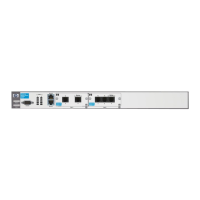B-28
Appendix B: Glossary
J
Japanese
Hierarchy
A digital signal hierarchy used in Japan for voice transmission. A J0 line is
defines a one channel. The Japanese hierarchy closely matches the T-carrier
system.
Table G-3. Japanese digital signal hierarchy
J1 The base bandwidth multiple of J-carrier systems. J1-carrier systems consist
of 24 J0 channels with a maximum transmission rate of 1.544 Mbps. The J1
standard is used for voice transmissions only.
K
Kbps Kilobits per second. One thousand bits per second. A measure of bandwidth
on a data transmission medium. Higher bandwidths are more conveniently
expressed in Megabits per second (Mbps or millions of bits per second) or in
Gigabits per second (Gbps, or billions of bits per second).
Key In cryptography, a key is a unique value or string of text that is combined with
data when that data is run through an encryption or hash algorithm. In order
to decrypt or dehash the data, a device must apply the correct key to the
transformed data. With symmetric keys, the same key encrypts and decrypts
(or hashes and dehashes) data. With asymmetric keys, a private key trans-
forms data and a public key reverses the transformation. The length of a key
generally determines how difficult it will be to decrypt the data.
KS Key System. A key system is essentially a scaled-down PBX. Key systems
typically have one unit, either an attendant phone or a separate box, that acts
as controller over a limited number of lines (usually about 4) for a limited
number of extensions (as many as 20).
Physical
carrier
DSD J0 multiple J1 multiple Transmission
rate
— J0 1 — 64 Kbps
J1 J1 24 — 1.544 Mbps
J2 J2 96 4 6.312 Mbps
J3 J3 480 30 32.064 Mbps
J4 J4 5760 240 397.200 Mbps

